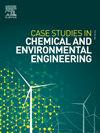Evaluation of the physical and chemical characteristics of waste excavated from an open dump site for sustainable waste management
Q1 Environmental Science
Case Studies in Chemical and Environmental Engineering
Pub Date : 2024-12-19
DOI:10.1016/j.cscee.2024.101069
引用次数: 0
Abstract
Waste management is a global concern with significant environmental and socio-economic impacts. In Indonesia, particularly in Serang City, challenges in waste processing are prevalent. This study explores the characteristics of waste and potential valorization strategies at the Cilowong disposal site. It involves sampling, physical and chemical composition testing, and nutrient content analysis. The waste density analysis reveals consistent values similar to other regional landfills. Fractionation indicates that materials under 10 mm have higher densities than those over 10 mm, with plastics dominating the larger fraction. Specifically, materials over 10 mm account for 59.88%, while those under 10 mm comprise 40.12%. The composition analysis highlights a high proportion of unsorted residual waste and plastics, with compost and biowaste showing decomposition. Notably, challenges in meeting standards for Refuse Derived Fuel (RDF) and compost quality highlight the necessity for pretreatment. The caloric value of the waste is 2,158 Kcal/kg, with a moisture content of 42.45% and ash content of 56.21%. Despite these values, the waste from Cilowong shows potential for RDF production and waste-to-energy applications. However, 1 mg/kg mercury contamination in compost raises concerns about its suitability for food crops. The fine fraction from landfill mining could serve alternative purposes, such as soil cover and environmental remediation. Effective waste valorization strategies are essential for improving landfill capacity and creating sustainable waste management solutions, especially for larger (>10 mm) and smaller (<10 mm) waste fractions.

评估露天排土场挖掘废物的物理及化学特性,以促进废物的可持续管理
废物管理是一个全球性问题,具有重大的环境和社会经济影响。在印度尼西亚,特别是在雪朗市,废物处理方面的挑战普遍存在。本研究探讨了基洛翁垃圾处理场的废物特征和潜在的增值策略。它包括取样、物理和化学成分测试以及营养成分分析。垃圾密度分析结果与其他区域垃圾填埋场相似。分异表明,小于10mm的材料比大于10mm的材料具有更高的密度,其中塑料占了较大的比例。其中,10mm以上材料占59.88%,10mm以下材料占40.12%。成分分析显示,未分类的残余废物和塑料占很大比例,堆肥和生物废物显示分解。值得注意的是,在满足垃圾衍生燃料(RDF)标准和堆肥质量方面的挑战突出了预处理的必要性。废渣热值为2158 Kcal/kg,水分含量为42.45%,灰分含量为56.21%。尽管有这些价值,来自Cilowong的废物显示出生产RDF和废物转化为能源的潜力。然而,堆肥中的汞污染为每公斤1毫克,这引起了人们对其是否适合用于粮食作物的担忧。从垃圾填埋场开采的细颗粒可以用于其他目的,如土壤覆盖和环境修复。有效的废物增值策略对于提高垃圾填埋场容量和创造可持续的废物管理解决方案至关重要,特别是对于较大(10毫米)和较小(10毫米)的废物组分。
本文章由计算机程序翻译,如有差异,请以英文原文为准。
求助全文
约1分钟内获得全文
求助全文
来源期刊

Case Studies in Chemical and Environmental Engineering
Engineering-Engineering (miscellaneous)
CiteScore
9.20
自引率
0.00%
发文量
103
审稿时长
40 days
 求助内容:
求助内容: 应助结果提醒方式:
应助结果提醒方式:


